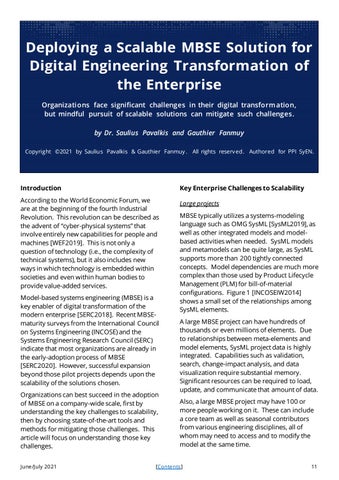FEATUREDARTICLES:
Deploying a Scalable MBSE Solution for Digital Engineering Transformation of the Enterprise Organizations face significant challenges in their digital transform ation, but mindful pursuit of scalable solutions can mitigate such challenges. by Dr. Saulius Pavalkis and Gauthier Fanmuy Copyright ©2021 by Saulius Pavalkis & Gauthier Fanmuy . All rights reserv ed. Authored for PPI SyEN.
Introduction
Key Enterprise Challenges to Scalability
According to the World Economic Forum, we are at the beginning of the fourth Industrial Revolution. This revolution can be described as the advent of “cyber-physical systems” that involve entirely new capabilities for people and machines [WEF2019]. This is not only a question of technology (i.e., the complexity of technical systems), but it also includes new ways in which technology is embedded within societies and even within human bodies to provide value-added services. Model-based systems engineering (MBSE) is a key enabler of digital transformation of the modern enterprise [SERC2018]. Recent MBSEmaturity surveys from the International Council on Systems Engineering (INCOSE) and the Systems Engineering Research Council (SERC) indicate that most organizations are already in the early-adoption process of MBSE [SERC2020]. However, successful expansion beyond those pilot projects depends upon the scalability of the solutions chosen. Organizations can best succeed in the adoption of MBSE on a company-wide scale, first by understanding the key challenges to scalability, then by choosing state-of-the-art tools and methods for mitigating those challenges. This article will focus on understanding those key challenges. June /July 2021
Large projects MBSE typically utilizes a systems-modeling language such as OMG SysML [SysML2019], as well as other integrated models and modelbased activities when needed. SysML models and metamodels can be quite large, as SysML supports more than 200 tightly connected concepts. Model dependencies are much more complex than those used by Product Lifecycle Management (PLM) for bill-of-material configurations. Figure 1 [INCOSEIW2014] shows a small set of the relationships among SysML elements. A large MBSE project can have hundreds of thousands or even millions of elements. Due to relationships between meta-elements and model elements, SysML project data is highly integrated. Capabilities such as validation, search, change-impact analysis, and data visualization require substantial memory. Significant resources can be required to load, update, and communicate that amount of data. Also, a large MBSE project may have 100 or more people working on it. These can include a core team as well as seasonal contributors from various engineering disciplines, all of whom may need to access and to modify the model at the same time.
[Conte nts ]
11







